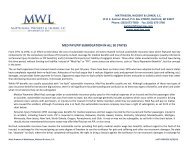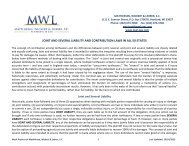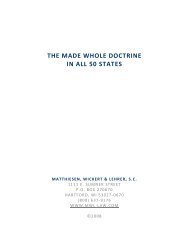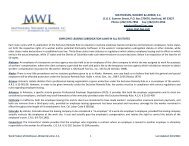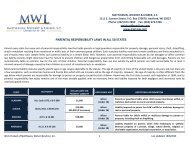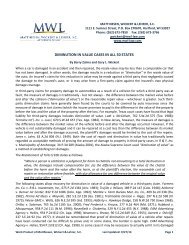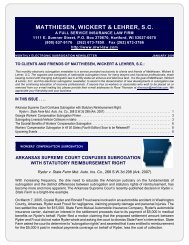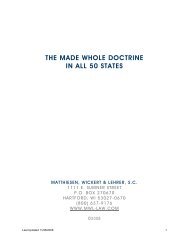matthiesen wickert lehrer, sc - Insurance Litigation Attorneys ...
matthiesen wickert lehrer, sc - Insurance Litigation Attorneys ...
matthiesen wickert lehrer, sc - Insurance Litigation Attorneys ...
You also want an ePaper? Increase the reach of your titles
YUMPU automatically turns print PDFs into web optimized ePapers that Google loves.
MATTHIESEN WICKERT LEHRER, S.C.<br />
ATTORNEYS AT LAW<br />
IIII EAST SUMNER STREET ! P.O. BOX 270670 ! HARTFORD, WI 53027-0670 ! TELEPHONE (262) 673-7850 ! FAX (262) 673-3766<br />
http://www.mwl-law.com<br />
MED PAY / PIP SUBROGATION IN ALL 50 STATES<br />
From 1971 to 1976, in an effort to hold down the cost of automobile insurance, 16 states enacted no-fault automobile insurance laws which featured two key<br />
components: (1) the compulsory purchase of first-party no-fault coverage for medical benefits and loss of income for drivers and passengers (usually referred to as<br />
Personal Injury Protection or PIP benefits); and (2) limited third-party tort liability of negligent drivers. Three other states enacted similar no-fault laws during this time<br />
period, without limiting tort liability. Instead of “Med Pay” or “PIP”, some states use other terms, such as “Basic Reparation Benefits”, but the concept is the same.<br />
The no-fault experiment has received mixed reviews over the past 30 years. There have been no states since 1976 who have adopted no-fault and several states<br />
have completely repealed their no-fault laws. Advocates of no-fault argue that it reduces litigation costs and payment for non-economic (pain and suffering, etc.)<br />
damages, and provides faster payment for losses. Opponents argue that no-fault unfairly benefits negligent drivers and point to statistics which show that rather than<br />
decreasing insurance premiums, it increases premiums. An excellent, albeit lengthy and somewhat technical, article on the merits of no-fault automobile insurance<br />
authored by Scott Harrington can be found by clicking on the below link. http://www.allbusiness.com/finance/insurance-liability-insurance/452934-1.html.<br />
While PIP benefits are usually associated with “no-fault” automobile insurance, Med Pay benefits usually are not. Although subrogation of these two types of<br />
automobile insurance benefits has become big business, there is still significant misunderstanding and confusion as to these two types of benefits, and when and<br />
under what circumstances they can be subrogated.<br />
Medical Payments (Med Pay) coverage under an automobile insurance policy pays for the medical expenses of an insured and his/her passengers after<br />
an accident. Automobile insurance laws vary from state to state, but this coverage generally includes accidents which occur while an insured is driving<br />
someone else’s vehicle with permission, or injuries to the insured or his/her family members while they are pedestrians. Med Pay will pay no matter who<br />
caused the accident, although if someone else is at fault, the automobile insurance company may have a right of subrogation, as set forth in the chart below.<br />
Personal Injury Protection (PIP) coverage pays benefits for medical expenses and lost wages incurred by the insured and his/her passengers injured in<br />
an accident, including funeral costs. PIP is required in Arkansas, Delaware, Florida, Hawaii, Kansas, Kentucky, Maryland, Massachusetts, Michigan,<br />
Minnesota, New Jersey, New York, North Dakota, Oregon, Pennsylvania, and Utah. It may or may not be subrogable, as set forth in the chart below. It<br />
should also be remembered that some states may offer Med Pay but not PIP, or vice-versa.<br />
No-fault automobile insurance laws involve the automobile carrier providing first-party medical and/or wage loss benefits, without regard to the fault of the insured,<br />
in exchange for the insured giving up some degree of freedom to sue the tortfeasor for pain and suffering and other non-economic damages. No state has “absolute”<br />
no-fault, where the driver completely relinquishes the right to bring a lawsuit against the tortfeasor for non-economic damages in exchange for first-party economic<br />
LAST UPDATED 9/16/08
loss benefits (PIP, Med Pay, or similar benefits). Michigan comes the closest. It provides unlimited no-fault coverage and makes it very difficult to sue for noneconomic<br />
damages. Some states use terms other than “Med Pay” and “PIP”, such as “Basic Reparation Benefits”, but the concept is the same.<br />
Today, state automobile insurance laws fall into four categories: (1) traditional tort liability system; (2) add-on states where the carrier pays no-fault PIP or Med Pay<br />
first-party benefits to insured, who retains the right to sue the third-party; (3) modified no-fault states where the carrier pays no-fault first-party benefits but the insured’s<br />
right to sue the third-party is restricted; and (4) choice states where insureds are offered a choice between traditional tort system and a no-fault system.<br />
Currently, eleven (11) states have “modified” no-fault automobile insurance laws, where first-party economic benefits are provided regardless of fault, and the right<br />
to sue for non-economic damages is allowed only after satisfying a statutorily-defined (monetary, verbal or combination of the two) threshold. Michigan, New Jersey,<br />
New York and Pennsylvania have verbal thresholds - one which defines in plain language the precise injury or a level of “serious injury” which must be met in order<br />
to sue. Hawaii, Kansas, Kentucky, Massachusetts, Minnesota, North Dakota and Utah have monetary thresholds, where a specific dollar amount of medical expenses<br />
must be reached before being able to sue.<br />
Three (3) states - New Jersey, Pennsylvania and Kentucky have “choice” no-fault. Under choice no-fault systems, drivers have the choice of being covered under<br />
either a pure no-fault policy, where you cannot sue third-parties for non-economic damages and are immune from such suits yourself; or a modified no-fault policy,<br />
where you can sue other drivers who have also chosen to retain their tort rights, and they can sue you. If a no-fault driver is in an accident with a modified no-fault<br />
driver, they are both unable to sue the other party.<br />
Nine (9) states have automobile insurance systems which offer add-on no-fault benefits. They are Arkansas, Delaware, Maryland, Oregon, South Carolina, South<br />
Dakota, Texas, Virginia, and Washington. These states offer PIP or similar benefits in varied amounts and under varied conditions, but do not restrict third-party<br />
lawsuits.<br />
The rest of the states operate under a traditional tort liability system where there are no limitations on the right to sue negligent third-parties.<br />
In no-fault states, there is little reason for an insured to purchase both Med Pay and PIP coverage, because PIP provides coverage equal to and beyond Med Pay<br />
(although PIP often has a deductible and Med Pay does not). Some states provide one but not the other. The recent trend has steered away from no-fault systems.<br />
The most recent state to convert from a no-fault system back to a traditional tort system is Colorado, which did so on July 1, 2003. For information on insurance limits,<br />
proof of insurance, and required/optional coverage available in each state, please see http://www.dmv.org/al-alabama/car-insurance.php. In a majority of states,<br />
statutes mandating PIP and uninsured motorist (UM) coverage typically specify that the “named insured” and “any insured named in the policy” has the right to reject<br />
such coverage.<br />
The following chart provides an overview of subrogation rights for PIP and/or Med Pay-type benefits paid under the automobile insurance laws of all 50 states. For<br />
information regarding the symbols found within the chart, please refer to the Chart Legend, which, for your convenience, has been placed both before and after the<br />
chart.<br />
Please note that this chart addresses not only the right of subrogation, but also whether and to what extent the made whole doctrine affects the insurer’s right of<br />
subrogation and/or reimbursement. This chart also makes general reference to each state’s current law regarding whether it applies the made whole doctrine and<br />
whether the doctrine can be contracted away with the appropriate policy language. Whether or not the insured’s attorney, if there is one, is entitled to reduce your<br />
subrogation interest based on his attorney’s fees and costs (common fund doctrine) is a separate issue which must be addressed on a case-by-case basis and is<br />
subject to the laws of the state at issue and insurance policy language.<br />
2 LAST UPDATED 9/16/08
STATE<br />
CHART LEGEND<br />
SYMBOL SYMBOL REPRESENTS<br />
+ No-fault state<br />
o PIP or similar first-party benefit (Med Pay) “Add-On” state<br />
Y Yes, there are some subrogation or reimbursement rights available<br />
N No, there are no subrogation or reimbursement rights available<br />
Y* Yes, there are additional details or limitations - look at the column to its right<br />
N* No, there are additional details or limitations - look at the column to its right<br />
- Indicates either the insurers in that state do not routinely offer such coverage or the coverage is unavailable<br />
? Law is unsettled as to whether the benefit can be subrogated, or that an argument can be made either way<br />
MED<br />
PAY<br />
AK Y -<br />
AL Y -<br />
MED PAY / PIP SUBROGATION IN ALL 50 STATES<br />
PIP AUTHORITY / ADDITIONAL INFORMATION<br />
MED PAY: Insurer has right of reimbursement. Maynard v. State Farm, 902 P.2d 1328 (Alaska 1995).<br />
PIP: Coverage not applicable.<br />
MADE WHOLE: Possible application to equitable subrogation only. McCarter v. Alaska National Ins. Co., 83 P.2d 525 (Alaska 1984).<br />
MED PAY: Contractual right of subrogation is enforceable. Wolfe v. Alfa Mut. Ins. Co., 880 So.2d 1163 (Ala. App. 2003).<br />
PIP: Coverage not applicable.<br />
MADE WHOLE: Can be overridden with Plan language. Ex parte State Farm Fire & Cas. Co. v. Hannig, 764 So.2d 543 (Ala. 2000).<br />
3<br />
LAST UPDATED 9/16/08
STATE<br />
MED<br />
PAY<br />
AR N Y Y<br />
AZ N* N*<br />
CA N* -<br />
CO N? -<br />
MED PAY / PIP SUBROGATION IN ALL 50 STATES<br />
PIP AUTHORITY / ADDITIONAL INFORMATION<br />
MED PAY and PIP: A.C.A. § 23-89-207. Insurer has only a lien and right of reimbursement and credit out of 3P recovery. Daves v. Hartford<br />
Acc. & Indem. Co., 788 S.W.2d 733 (Ark. 1990). “Medical and Hospital Benefits”, “Income Disability Benefits” and “Accidental Death Benefits”<br />
are paid under A.C.A. § 23-89-202.<br />
MADE WHOLE: Uses “Franklin formula”. Reimbursement is amount of 3P recovery plus insurance proceeds exceeding insured’s loss and<br />
collection costs. South Central Ark. Elec. Coop. v. Buck, 117 S.W.3d 591 (Ark. 2003). Cannot be overridden by Plan language. Franklin v.<br />
Healthsource of Ark., 942 S.W.2d 837 (Ark. 1997).<br />
N “Add-on” PIP state. No significant limitation on 3P lawsuits.<br />
MED PAY and PIP: No direct subrogation right. Assignment of personal injury cause of action is prohibited. Allstate Ins. Co. v. Druke, 576 P.2d<br />
489 (Ariz. 1978).<br />
MADE WHOLE: Not applicable. However, § 20-259.01(J) requires insurer to compromise its Med Pay lien “in a fair and equitable manner”.<br />
* Carrier can perfect lien against any 3P recovery for any Med Pay benefits in excess of $5,000 by recording lien within 60 days after payment<br />
with the office of the recorder for the county in which the accident occurred. A.R.S. § 20-259.01(J). Copies of lien with relevant information must<br />
be sent to insured and all third-parties.<br />
MED PAY: *Insurer entitled to reimbursement rights only, based on policy provisions authorizing same. Allstate Ins. Co. v. Superior Ct.<br />
(Delanzo), 67 Cal. Rptr.3d 178 (Cal. 2007). No direct subrogation allowed because assignment of personal injury actions is not allowed.<br />
PIP: Coverage not applicable.<br />
th<br />
MADE WHOLE: Can be overridden with Plan language. Samura v. Kaiser Foundations Health Plan, 17 Cal.App.4 1284 (Cal. App. 1993).<br />
MED PAY: Direct subrogation and reimbursement allowed on policies issued or renewed before 1/1/09. No direct subrogation action against<br />
tortfeasors for policies issued, delivered or renewed after 1/1/09. Possible reimbursement claim after 1/1/09 under newly amended § 10-4-<br />
635(3)(a). No specific case or statute for authority due to recent sunset of no-fault.<br />
PIP: Coverage not applicable.<br />
MADE WHOLE: Applied in UM situations only to date. Kral v. American Hardware Mut. Ins. Co., 784 P.2d 759 (Colo. 1989). Applies only when<br />
legislatively-mandated coverage would be reduced by subrogation rights such as UM, PIP and/or no-fault. Marquez v. Prudential Prop. Cas.<br />
Ins. Co., 620 P.2d 29, 32 (Colo. 1980).<br />
Adopted no-fault in 1974, but was allowed it to expire in 2003. C.R.S. § 10-4-713(1) (repealed) prohibited carriers paying no-fault benefits from<br />
subrogating unless it involved a “non-private passenger motor vehicle” as defined in § 10-4-713(2)(a).<br />
4<br />
LAST UPDATED 9/16/08
STATE<br />
MED<br />
PAY<br />
CT Y? -<br />
DC Y Y<br />
DE N - Y<br />
MED PAY / PIP SUBROGATION IN ALL 50 STATES<br />
PIP AUTHORITY / ADDITIONAL INFORMATION<br />
MED PAY: Connecticut collateral source rule (C.G.S.A. § 52-225c) prohibits subrogation of collateral source unless a right of subrogation<br />
pursuant to another Connecticut statute. Clemens v. Graham, 2003 WL 22961336 (Conn. Super. 2003). Argument can be made Conn. Admin.<br />
Code § 38a-334-7(c)(3) allows auto policy to contain a subrogation clause for medical payment benefits. Nuzzo v. Nationwide, 1997 WL 790651<br />
(Conn. Super. 1999) prohibits mere equitable subrogation in light of anti-subrogation rule of § 52-225c.<br />
PIP: Coverage not applicable since 1993.<br />
MADE WHOLE: Can be overridden with Plan language. The Automobile Ins. Co. of Hartford v. Conlon, 216 A.2d 828 (Conn. 1966).<br />
Adopted no-fault in 1973, but repealed it in 1993.<br />
MED PAY: Insurers are not prohibited by law from providing PIP benefits.<br />
PIP: § 31-2411(d). One vehicle must be other than a “passenger motor vehicle”. Victim must elect PIP within 60 days after accident.<br />
MADE WHOLE: Can be overridden with Plan language. District 1-Pacific Coast Distributors v. Travelers, 782 A.2d 269 (D.C. 2001).<br />
Adopted no-fault in 1983, but repealed it in 1986.<br />
MED PAY: Coverage not applicable.<br />
PIP: Statutory right of subrogation for reimbursement under 21 Del. C. § 2118(g) exists only against 3P’s liability carrier - not tortfeasor<br />
individually. Subrogation rights only against 3P policy limits remaining after insured settles with 3P. Carrier can’t join insured’s 3P lawsuit. 3P<br />
carrier can settle with PIP carrier before the insured, but must reimburse insured if 3P claim and subrogation recovery exceed 3P policy limits.<br />
Harper v. State Farm Mut. Auto. Ins. Co., 703 A.2d 136 (Del. Supr. 1997).<br />
MADE WHOLE: No case law. See PIP Statute above.<br />
N “Add-on” PIP state. No significant limitation on 3P lawsuits, but insured can’t recover no-fault benefits from tortfeasor. Uninsured driver without<br />
no-fault insurance can sue tortfeasor in tort. Redding v. Ortega , 840 A.2d 1224 (Del. 2003).<br />
5<br />
LAST UPDATED 9/16/08
STATE<br />
MED<br />
PAY<br />
FL + Y? N<br />
GA N N*<br />
HI +<br />
Y* Y<br />
MED PAY / PIP SUBROGATION IN ALL 50 STATES<br />
PIP AUTHORITY / ADDITIONAL INFORMATION<br />
MED PAY: Unclear. Allstate v. Rudnick, 761 So.2d 289 (Fla. 2000) declared Med Pay benefits are collateral source under F.S.A. § 768.76, but<br />
not whether Med Pay benefits were a type of “collateral source” which was subrogable under § 768.76(3).<br />
PIP: Subrogation prohibited by F.S.A. § 627.736(3). PIP benefits set off from verdict or recovery under § 627.736(3). Subrogation allowed if<br />
P’s vehicle is “commercial motor vehicle” or P is pedestrian struck by “commercial motor vehicle.” § 627.7405. PIP coverage available as of<br />
1/1/08.<br />
MADE WHOLE: Can be overridden with Plan language. Florida Farm Bureau, Inc. v. Martin, 377 So.2d 827 (Fla. App. 1979).<br />
+ No-fault state. Verbal threshold. Minimum of $10,000 in PIP coverage required. Suit against another insured vehicle allowed only if reaches<br />
“tort threshold” of (1) significant and permanent loss of bodily function, (2) permanent injury, (3) <strong>sc</strong>arring or disfigurement, or (4) death. Even<br />
if P doesn’t reach tort threshold, can still recover 20% of past med expenses and 40% of lost income not payable under no-fault. Tortfeasor liable<br />
for med expenses and lost wages that exceed PIP limits.<br />
MED PAY: Optional under O.C.G.A. § 33-34-4 (a/k/a “PIP” benefits). No subrogation under O.C.G.A. § 33-24-56.1. See also Wrightsman v.<br />
Hardware Dealers Mut. Fire Ins. Co., 147 S.E.2d 860 (Ga. App. 1966).<br />
PIP: * Subrogation allowed only if one of the vehicles in the accident weighs more than 6,500 lbs. unloaded. See O.C.G.A. § 33-34-3.<br />
MADE WHOLE: Can be overridden with Plan language. Duncan v. Integon General Ins. Co., 482 S.E.2d 325 (Ga. 1997).<br />
Adopted no-fault in 1975, but repealed it in 1991.<br />
MED PAY: Insurers are not prohibited by law from providing PIP benefits.<br />
PIP: Haw. Rev. Stat. § 431:10C-307allows PIP insurer to be subrogated to 50% of the amount of no-fault benefits paid which are duplicated<br />
in 3P recovery. Cannot subrogate against optional additional coverages such as UM/UIM. See Sol v. Hawaii Ins. Co., 875 P.2d 921 (Haw. 1994).<br />
Note: SOL runs two years after last payment of no-fault benefits. Haw. Rev. Stat. § 431:10C-315. 3P suit allowed against another insured vehicle<br />
only if death, loss of use of a part or function of the body, permanent and serious disfigurement, or medical bills more than $5,000. See Haw.<br />
Rev. Stat. § 431:10C-306. Any 3P recovery reduced by amount of PIP benefits paid, i.e., $5K to $10K (“covered loss deductible”). See Haw.<br />
Rev. Stat. § 431:10C-301.5. 3P suits less than $5K not allowed. If med expenses between $5K and $10K, amount of PIP benefits subtracted<br />
from verdict/recovery. See State Farm v. Gepaya, 80 P.3d 321 (Haw. 2003).<br />
MADE W HOLE: Applied only to UM cases to date. Subrogation rights determined by contract, not equity. State Farm Fire & Cas. v. Pacific Rent-<br />
All, 978 P.2d 753 (Haw. 1999).<br />
+ No-fault state. Monetary and verbal thresholds. Enacted in 1974.<br />
6<br />
LAST UPDATED 9/16/08
STATE<br />
MED<br />
PAY<br />
IA Y Y<br />
ID Y -<br />
IL Y -<br />
IN Y -<br />
KS + N Y<br />
MED PAY / PIP SUBROGATION IN ALL 50 STATES<br />
PIP AUTHORITY / ADDITIONAL INFORMATION<br />
MED PAY: Ludwig v. Farm Bureau Mutual Ins. Co., 393 N.W.2d 143 (Iowa 1986).<br />
PIP: Insurers are not prohibited by law from providing PIP benefits.<br />
MADE WHOLE: Can be overridden with Plan language. Ludwig, supra.<br />
MED PAY: Idaho Code § 41-2505. Rinehart v. Farm Bur. Mut. Ins. Co. of Idaho, 524 P.2d 1343 (Idaho 1974).<br />
PIP: Coverage not applicable.<br />
MADE WHOLE: No reported state court cases applying doctrine.<br />
MED PAY: Claim for reimbursement only - not direct subrogation - as personal injury actions not assignable. Spirek v. State Farm, 382 N.E.2d<br />
111 (Ill. App. 1978). No equitable subrogation. Recovery rights depend on policy terms. No intervention necessary. Trogub v. Robinson, 853<br />
N.E.2d 59 (Ill. App. 2006). Exception when same carrier pays Med Pay and UM and arbitrators determine total damages exceed 3P limits.<br />
Glidden v. Farmer, 312 N.E.2d 106 (Ill. App. 2003).<br />
PIP: Not generally sold in Illinois. No special statute limiting suit or providing credit if PIP is present.<br />
MADE WHOLE: Made whole doctrine not applicable and can be overridden with Plan language. Eddy v. Sybert, 783 N.E.2d 106 (Ill. App. 2003).<br />
MED PAY: Erie Ins. Co. v. George, 658 N.E.2d 950 (Ind. App. 1996), opinion vacated, 681 N.E.2d 983 (Ind. 1997); See also I.C. §§ 34-53-1-1<br />
(subrogation rights and lien) and § 34-53-1-2 (common fund costs and fees). See also I.C. § 34-4-41-1 with regard to sharing attorney’s fees<br />
and costs.<br />
PIP: Coverage not applicable.<br />
MADE WHOLE: Can be overridden with Plan language. Erie Ins. Co. v. George, supra.<br />
MED PAY: Coverage not applicable.<br />
PIP: Carrier can subrogate once $2,000 no-fault threshold met. K.S.A. § 40-3113a(b). PIP carrier can sue 3P directly after 18 months. K.S.A.<br />
§ 40-3113a(c). Subro recovery reduced by injured party’s % of negligence. K.S.A. § 40-3113a(c). State Farm v. Kroeker, 676 P.2d 66 (Kan.<br />
1984). Subrogation recovery limited to those damages which are duplicative of PIP benefits paid.<br />
MADE WHOLE: Can be overridden with Plan language. Unified School Dist. No. 259 v. Sloan, 871 P.2d 861, 865 (Kan. 1994).<br />
+ No-fault state. Monetary threshold. Enacted in 1974. Pain and suffering recoverable only if (1) medical expenses exceed $2,000; (2)<br />
permanent injury; (3) fracture of weight-bearing bone; or (4) disfigurement. K.S.A. § 40-3117.<br />
7<br />
LAST UPDATED 9/16/08
STATE<br />
MED<br />
PAY<br />
KY + Y Y*<br />
LA Y -<br />
MA + N Y<br />
MD N N N<br />
MED PAY / PIP SUBROGATION IN ALL 50 STATES<br />
PIP AUTHORITY / ADDITIONAL INFORMATION<br />
MED PAY: Optional coverage. Subrogation allowed. State Farm Mutual Automobile Ins. Co. v. Roark, 517 S.W.2d 737 (Ky. 1974).<br />
PIP: If injury caused by “unsecured person”, injured party’s “reparation obligor” (subrogated carrier) can subrogate (obtain Basic Reparation<br />
Benefits [“BRB”] reimbursement directly from the unsecured person). But if injury is caused by a “secured person”, the carrier can obtain BRB<br />
reimbursement only from secured person’s reparation obligor (3P carrier). City of Louisville v. State Farm, 194 S.W.3d 304 (Ky. 2006); K.R.S.<br />
§ 304.39-070(2)(3).<br />
MADE WHOLE: Can be overridden with Plan language. Wine v. Globe Am. Cas. Co., 917 S.W.2d 558 (Ky. 1996).<br />
+ Choice No-fault state. Monetary and verbal threshold. Enacted in 1975. *3P tort action allowed if medicals exceed $1,000 or if injury results<br />
in permanent disfigurement, permanent injury, permanent loss of bodily function, or death. K.R.S. § 304.39-060(2)(b).<br />
MED PAY: Subrogation per policy terms. Theriot v. Bergeron, 552 So.2d 1 (La. App. 1989). See La. Civ. Code §§ 1825-1827.<br />
PIP: Coverage not applicable.<br />
MADE WHOLE: Known as “Full Compensation Rule”. Southern Farm Bur. Cas. Ins. Co. v. Sonnier, 406 So.2d 178 (La.1981). Burden on insurer.<br />
MED PAY: There is no Med Pay reimbursement provision in Massachusetts’ law.<br />
PIP: M.G.L.A. Ch. 90, § 34M. Carrier subrogated only to extent of its payments to insured, so can’t release 3P for all insured’s claims. Parrell<br />
v. Keenan, 452 N.E.2d 506 (Mass. 1983)<br />
MADE WHOLE: Can be overridden with Plan language. Morin v. Massachusetts Blue Cross, Inc., 311 N.E.2d 914 (Mass. 1974).<br />
+ No-fault state. Monetary threshold. Enacted in 1971. M.G.L.A. Ch. 90, §§ 34A, 34M, 34N & 34O. Medicals, lost wages and replacement<br />
services no-fault benefits recoverable up to $8,000. M.G.L.A. § 34M. Third-party suit allowed if medicals exceed $2,000 or (1) death; (2) loss<br />
of body part; (3) disfigurement; (4) loss of hearing or sight; or (5) fractured bone. M.G.L.A. Ch. 231, § 6D.<br />
MED PAY: No subrogation. Md. Code, Ins. § 19-109. Optional first-party coverage.<br />
PIP: No right of subrogation. Md. Code, Ins. § 19-507.<br />
MADE WHOLE: Can be overridden with Plan language. Stancil v. Erie Ins. Co., 740 A.2d 49-50 (Md. Ct. of Special App. 1999).<br />
N “Add-on” PIP state. PIP coverage is mandated. No significant limitation on 3P suits.<br />
8<br />
LAST UPDATED 9/16/08
STATE<br />
MED<br />
PAY<br />
ME Y -<br />
MI + N Y*<br />
MN + - N<br />
MED PAY / PIP SUBROGATION IN ALL 50 STATES<br />
PIP AUTHORITY / ADDITIONAL INFORMATION<br />
MED PAY: $2,000 in Med Pay coverage required. 29-M.R.S.A. § 2910-A. Limited subrogation allowed, less a prorated portion of recovery costs.<br />
24-A M.R.S.A. § 2910-A. Subrogation clause must be in policy and must have insured’s prior written approval. York Ins. Group of Maine v. Van<br />
Hall, 704 A..2d 366 (Me. 1997).<br />
PIP: Coverage not applicable.<br />
MADE WHOLE: Applies only when legislatively-mandated coverage is reduced by subrogation rights such as UM, PIP and/or no-fault. We<strong>sc</strong>ott<br />
v. Allstate Ins. Co., 397 A.2d 156 (Me. 1979).<br />
MED PAY: Same as PIP.<br />
PIP: Subrogation allowed if (1) involves accident occurring outside of Michigan; (2) claim against uninsured motorist; or (3) based on intentional<br />
harm. M.C.L.A. § 500.3116(2). Insured must reimburse PIP carrier to extent of benefits received, up to settlement amount (exclusive of<br />
attorneys’ fees/costs). PIP carrier has lien on case. State Auto Ins. Co. v. Velazquez, 703 N.W.2d 223 (Mich. App. 2005). Third-party recovery<br />
for non-economic loss or PIP benefits in excess of PIP amount paid by insurer not subject to reimbursement. M.C.L.A. § 500.3116(4). Lien can<br />
be avoided by judicial determination that 3P recovery is non-economic only. Allstate Ins. Co. v. Jewell, 482 N.W.2d 896 (Mich. App. 1990).<br />
MADE WHOLE: Made whole doctrine applied. Washtenaw Mut. Fire Ins. Co. v. Budd, 175 N.W. 231 (Mich. 1919).<br />
+ No-fault state. Verbal threshold. Enacted in 1973. No-fault benefits cover medical costs, lost wages up to 3 years, and replacement services.<br />
No 3P suit allowed unless (1) intentional act; (2) non-economic damages for death, serious impairment or disfigurement; or (3) loss of wages<br />
and survivor’s loss in excess of daily, monthly and specified time limitations in the No-Fault Act. M.C.L.A. § 500.3135. If threshold is met, can<br />
sue for economic damages above and beyond no-fault benefits received and non-economic damages. Limited property damage liability (“minitort”)<br />
allows victim to recover up to $500 of vehicle repair costs (deductible). Primary focus of 3P litigation involves non-economic damages.<br />
MED PAY: Coverage not applicable.<br />
PIP: Subrogation allowed only if claim is based on other than negligence in maintenance or use of insured motor vehicle, such as intentional<br />
tort, strict or statutory liability, or negligence other than use or operation of motor vehicle. M.S.A. § 65B.53; Banks v. Grant, 530 N.W.2d 864<br />
(Minn. App. 1994). Exception: if 3P is commercial vehicle more than 5,500 lbs. curb weight and if negligence in the operation, maintenance or<br />
use of the commercial vehicle (no buses) is alleged. See M.S.A. § 65B.53(1).<br />
MADE WHOLE: Can be overridden with Plan language. Westerndorf v. Stasson, 330 N.W.2d 699 (Minn. 1983); Medica, Inc. v. Atlantic Mutual<br />
Ins. Co., 566 N.W.2d 74, 77 (Minn. 1997).<br />
+ No-fault state. Monetary threshold. Enacted in 1975. Insured can file 3P suit for non-economic damages if they meet threshold of (1) death;<br />
(2) permanent injury/disfigurement; (3) disability more than 60 days; and (4) more than $4,000 in medical expenses. M.S.A. § 65B.51(3)(a)(b).<br />
Economic losses not subject to threshold. Uninsured driver can recover economic losses from insured tortfeasor. Munoz v. Kihlgren, 661 N.W.2d<br />
301 (Minn. App. 2003).<br />
9<br />
LAST UPDATED 9/16/08
STATE<br />
MED<br />
PAY<br />
MO N N<br />
MS Y -<br />
MT Y Y<br />
NC Y* -<br />
MED PAY / PIP SUBROGATION IN ALL 50 STATES<br />
PIP AUTHORITY / ADDITIONAL INFORMATION<br />
MED PAY: No subrogation because personal injury cause of action not assignable. Forsthove v. Hardware Dealers Mut. Fire Ins. Co., 416<br />
S.W.2d 208 (Mo. App. 1966).<br />
PIP: Same as Med Pay.<br />
MADE WHOLE: Doctrine applies. Hayde v. Womach, 707 S.W.2d 839 (Mo. App. 1986).<br />
th<br />
MED PAY: Tucker v. Aetna Cas. & Sur. Co., 801 F.2d 728 (5 Cir. 1986). Policy may provide for reimbursement. M.C.A. § 63-15-43(8). Carrier<br />
must obtain an assignment from insured before it can proceed against 3P. Preferred Risk Mut. Ins. Co. v. Courtney, 393 So.2d 1328 (Miss.<br />
1981).<br />
PIP: Coverage not applicable.<br />
MADE WHOLE: Doctrine applies. Cannot override with Plan language. Hare v. State of Miss., 733 So.2d 277 (Miss. 1999).<br />
MED PAY: Swanson v. Hartford Ins. Co. of Midwest, 46 P.3d 584 (Mont. 2002). Subrogation clauses for Med Pay and PIP, once declared<br />
against public policy, are again enforceable. However, this subrogation right is conditioned upon insured being made whole for all elements of<br />
damages, including payment of attorneys’ fees, regardless of any Plan language to the contrary.<br />
PIP: Same as Med Pay.<br />
MADE WHOLE: Doctrine applies. Cannot be overridden with Plan language. Swanson, supra.<br />
MED PAY: Med Pay carrier can subrogate through or seek reimbursement from insured, who has legal title to the one, indivisible cause of action<br />
against the tortfeasor. Policy must provide for same. Carver v. Mills, 207 S.E.2d 394 (N.C. App. 1974); Moore v. Beacon Ins. Co., 284 S.E.2d<br />
136 (N.C. App. 1981); Wilson v. Tennessee Farmers Mut. Ins. Co., 411 S.W.2d 699 (Tenn. 1966). *Caution: Standard auto policy has<br />
subrogation clause, but it is inapplicable to Med Pay benefits. Therefore, in order to subrogate, the policy must somehow reflect that right. See<br />
Wrightsman v. Hardware Dealers Mut. Fire Ins. Co., 147 S.E.2d 860 (Ga. App. 1966), which holds that subrogation clause in Med Pay<br />
endorsement is void as attempted assignment of personal injury claim.<br />
PIP: Coverage not applicable.<br />
MADE WHOLE: Mentioned in one case only. Not applied. St. Paul Fire & Marine Ins. Co. v. W.P. Rose Supply Co., 19 N.C. App. 302 (1973).<br />
10<br />
LAST UPDATED 9/16/08
STATE<br />
MED<br />
PAY<br />
ND + - N*<br />
NE Y -<br />
NH N -<br />
MED PAY / PIP SUBROGATION IN ALL 50 STATES<br />
PIP AUTHORITY / ADDITIONAL INFORMATION<br />
MED PAY: Coverage not applicable.<br />
PIP: No right of subrogation directly against another insured person. N.D.C.C. § 26.1-41-16.<br />
MADE WHOLE: Not applied in North Dakota.<br />
*Subrogation against tortfeasor can be pursued only for benefits paid in excess of basic no-fault benefits. Imperial Cas. & Indem. Co. v. General<br />
Cas. Co. of Wis., 458 N.W.2d 335 (N.D. 1990). There used to be equitable allocation of losses among insurers (i.e., loss transfer) by agreement<br />
or arbitration, but § 26.1-41-17 was repealed in 2005 and such allocation is no longer available. Now, no-fault carrier can subrogate against<br />
3P’s insurer only if “serious injury” or if one vehicle weighs in excess of 6,500 lbs. See N.D.C.C. § 26.1-41-17.<br />
+ No-fault state. Monetary threshold. Enacted in 1976. No-fault carrier pays the first $10,000 of medical expenses and workers’ compensation<br />
carrier pays the rest. N.D.C.C. § 26.1-41-13(3). Insured cannot sue tortfeasor for non-economic damages unless there is “serious injury.”<br />
N.D.C.C. § 26.1-41-08.<br />
MED PAY: Subrogation clause in auto insurance policy is valid and binding. Milbank Ins. Co. v. Henry, 441 N.W.2d 143 (Neb. 1989). If<br />
insured/claimant receives less than actual economic loss from all 3Ps, subrogation of Med Pay allowed only in same proportion that Med Pay<br />
benefits bear to total economic loss. Any recovery by settlement or judgment less than 3P policy limits is conclusively presumed a complete<br />
recovery of actual economic loss. Neb. Rev. Stat. § 44-3,128.01.<br />
PIP: Coverage not applicable.<br />
MADE WHOLE: Can be overridden with Plan language. Ploen v. Union Ins. Co., 573 N.W.2d 436 (Neb. 1998).<br />
MED PAY: Subrogation prohibited by statute. N.H. Rev. Stat. Ann. § 264:17.<br />
PIP: Coverage not applicable. First-party Med Pay coverage available instead.<br />
MADE WHOLE: Doctrine applies. Dimick v. Lewis, 497 A.2d 1221 (N.H. 1985).<br />
New Hampshire is a quasi-“add-on” state with limited Med Pay benefits. No limitations on 3P lawsuits.<br />
11<br />
LAST UPDATED 9/16/08
STATE<br />
MED<br />
PAY<br />
NJ + N N*<br />
NM Y -<br />
NV N -<br />
MED PAY / PIP SUBROGATION IN ALL 50 STATES<br />
PIP AUTHORITY / ADDITIONAL INFORMATION<br />
MED PAY and PIP: No subrogation rights exist where PIP benefits are paid, even when tortfeasor is not covered by no-fault insurance. Latimer<br />
v. Boucher, 458 A.2d 528 (N.J. Super. 1983). See N.J.S.A. § 39:6A-12 (no-fault benefit payment evidence exclusionary rule). *May be able to<br />
subrogate against commercial vehicle or livery vehicle (many rules and exceptions). N.J.S.A. § 39:6A-9.1 provides a PIP insurer with a direct<br />
action for reimbursement against certain parties within two years (any tortfeasor not required to or who failed to maintain no-fault PIP or Med<br />
Pay benefits coverage, and can be against 3P’s insurer only, and only by agreement or arbitration). Example: commercial and public vehicles,<br />
and some out-of-state vehicles. State Farm v. Licensed Beverage Ins. Exch., 679 A.2d 620 (N.J. 1996). This creates a “new direct right of action”<br />
in the insurer that is “primary and not linked to any purported subrogation rights.” Hanover Ins. Co. v. Borough of Atlantic Highlands, 709 A.2d<br />
236 (N.J. Super. 1998). There is no right of subrogation or reimbursement against a public entity. N.J.S.A. § 59:9-2(e).<br />
MADE WHOLE: Can be overridden with Plan language. Providence Washington Ins. Co. v. Hogges, 171 A.2d 120,124 (N.J. 1961).<br />
+ Choice No-fault state. No-fault verbal threshold optional. No-fault introduced in 1973 with monetary threshold, which was changed to verbal<br />
threshold in 1988. In 1998, the law allowed consumers to choose between “standard auto policy” and “basic auto policy”. Standard policy<br />
requires choice of tort options: (1) verbal threshold (can recover non-economic damages only when death, dismemberment, disfigurement or<br />
permanent injury); or (2) traditional tort option (unrestricted recovery of non-economic damages). N.J.S.A. § 39:6A-43. Default is verbal.<br />
MED PAY: Carrier entitled to both subrogation and reimbursement rights. Jimenez v. Foundation Reserve Ins. Co., 757 P.2d 792 (N.M. 1988).<br />
PIP: Coverage not applicable.<br />
MADE W HOLE: Doctrine of Equitable Apportionment applies. Subrogation interest reduced proportional to reduction of insured’s total claim.<br />
Amica Mutual Ins. Co. v. Maloney, 903 P.2d 834 (N.M. 1995).<br />
MED PAY: Med Pay subrogation clauses violates public policy and are void. Maxwell v. Allstate Ins. Co., 728 P.2d 812 (Nev. 1986).<br />
PIP: Coverage not applicable. First-party Med Pay coverage available instead.<br />
MADE WHOLE: Doctrine applies. Canfora v. Coast Hotels & Casinos, Inc., 121 P.3d 599 (Nev. 2005).<br />
No-fault repealed in 1980. Nevada is a quasi-“add-on” state with limited benefits.<br />
12<br />
LAST UPDATED 9/16/08
STATE<br />
MED<br />
PAY<br />
NY + - Y*<br />
OH Y Y<br />
OK N* -<br />
MED PAY / PIP SUBROGATION IN ALL 50 STATES<br />
PIP AUTHORITY / ADDITIONAL INFORMATION<br />
MED PAY: Med Pay benefits are called PIP, APIP or OBEL benefits in New York.<br />
PIP: No subrogation for first-party basic PIP benefits. N.Y. Ins. § 5104(a). Exceptions: (a) at least one vehicle weighs more than 6,500 lbs. or<br />
(b) one vehicle is used for transportation of person or property for hire (livery). This is done through inter-company Loss Transfer arbitration.<br />
There is also mandatory arbitration of “priority of payment” or “joint coverage” situations and voluntary UM arbitration. N.Y. Ins. § 5105(b). There<br />
is no lien or subrogation when both vehicles are insured.<br />
MADE WHOLE: Doctrine applies. Winkelmann v. Excelsior Ins. Co., 640 N.Y.S.2d 994 (N.Y. 1995).<br />
*Carrier can subrogate against a non-covered person and has a lien. N.Y. Ins. § 5104(b). Carrier also has common law subrogation rights for<br />
APIP benefits (additional PIP benefits in excess of basic PIP benefits) but does not have lien where APIP benefits not included in insured’s 3P<br />
lawsuit. This recovery claim does not qualify for inter-company arbitration. Federal Ins. Co. v. Hansen, 162 A.D.2d 224 (N.Y.A.D. 1990). Under<br />
N.Y. Veh.& Traf. Law § 341, a 3P lawsuit can be brought if a “serious injury” is sustained and monetary damages and/or non-economic damages<br />
exceed the no-fault PIP benefits. OBEL payments are treated as no-fault benefits.<br />
+ No-fault state. Verbal threshold. Enacted in 1974. No-fault law provides for payment of “basic economic losses” up to $50,000. N.Y. Ins. §<br />
5104 allows for 3P suit for such basic economic losses or non-economic losses only if there is a “serious injury.” See N.Y. Ins. § 5102 (death,<br />
dismemberment, or serious disfigurement).<br />
MED PAY: Carrier entitled to subrogation and/or reimbursement, depending on policy language. Craven v. Nationwide Mutual Ins. Co., 1998<br />
WL 158980 (Ohio App. 1998).<br />
PIP: Coverage can be offered by insurers.<br />
MADE W HOLE: Can be overridden by policy terms. Northern Buckeye Educ. Counsel Group Health Benefits Plan v. Lawson, 814 N.E.2d 1210,<br />
1215 (Ohio 2004).<br />
MED PAY: Subrogation clause in policy violates common-law rule on non-assignability of cause of action in tort, and is void as between insurer<br />
and tortfeasor. 36 Okla. Stat. Ann. § 6092. *Exception exists for benefits paid to anyone other than named insured or named insured’s family<br />
members (“relative”).<br />
PIP: Coverage not applicable.<br />
MADE WHOLE: Can be overridden by policy terms. Williams & Miller Gin Co. v. Baker Cotton Oil Co., 235 P.2d 185 (Okla. 1925).<br />
13<br />
LAST UPDATED 9/16/08
STATE<br />
MED<br />
PAY<br />
OR N - Y<br />
PA + N N<br />
RI Y -<br />
SC N N N<br />
MED PAY / PIP SUBROGATION IN ALL 50 STATES<br />
PIP AUTHORITY / ADDITIONAL INFORMATION<br />
MED PAY: Coverage not applicable.<br />
PIP: Auto carrier has right of reimbursement for PIP benefits (known as “make-half provision”) to the extent that total amount of benefits paid<br />
exceed insured’s economic damages. O.R.S. § 742.544. Subrogation/reimbursement available under § 742.534 (inter-insurer reimbursement),<br />
§ 742.536 (injured party must give notice to insurer of any claim or legal action, and insurer can give notice of election to seek reimbursement<br />
within 30 days, and this constitutes a lien), or § 742.538 (if inter-insurer reimbursement not available and no lien election made by insurer, the<br />
insured must hold any recovery in trust and insurer will be reimbursed, less share of costs and attorneys’ fees). (Eff. 1/1/08). See also §<br />
742.520(6). See Gaucin v. Farmers Ins. Co., 146 P.3d 370 (Or. App. 2006).<br />
MADE WHOLE: Doctrine applies generally to subrogation. Koch v. Spann, 92 P.3d 146 (Or. App. 2004). Under O.A.R. § 31.710 PIP<br />
subrogation/reimbursement not allowed until insured recovers his economic damages (“make-half rule”).<br />
N “Add-on” PIP state. $15,000 limits of PIP coverage required.<br />
MED PAY and PIP: Subrogation prohibited in any action arising out of use or maintenance of motor vehicle. 75 Pa. C.S.A. § 1720.<br />
MADE WHOLE: Doctrine passively applies. Lexington Ins. Co. v. Q-E Mfg. Co., Inc., 2006 WL 2136244 (M.D. Pa. 2007).<br />
+ Choice No-fault state. Verbal threshold. Enacted in 1976. Repealed strict no-fault in 1984, but maintained compulsory PIP coverage. In 1990,<br />
Pennsylvania allowed consumers to choose tort limitations in exchange for premium di<strong>sc</strong>ount on liability insurance. Insured can choose “limited<br />
tort option” which has lower premiums but limits recovery to economic damages (unless “serious injury”). Other choice is “full tort option”, which<br />
allows 3P suit for economic and non-economic damages.<br />
MED PAY: Subrogation allowed subject to pro rata sharing of costs of recovery. Jennings v. Nationwide Ins. Co., 669 A.2d 534 (R.I. 1996).<br />
PIP: Coverage not applicable.<br />
MADE WHOLE: Applies when legislatively-mandated coverage is reduced by subrogation rights such as UM, PIP and/or no-fault. Lombardi<br />
v. Merchant Mut. Ins. Co., 429 A.2d 1290 (R.I. 1981).<br />
MED PAY: S.C. Code § 38-77-144. PIP and Med Pay coverage may not be subrogated.<br />
PIP: Same as Med Pay.<br />
MADE WHOLE: Not applied in South Carolina.<br />
N “Add-on” PIP state. PIP or similar first party benefits are “added on” with no limitation on 3P lawsuits. First-party basic no-fault-type benefits<br />
are recoverable by injured party unless they have rejected tort limitations. Insureds must choose whether bound by verbal threshold.<br />
14<br />
LAST UPDATED 9/16/08
STATE<br />
MED<br />
PAY<br />
SD N Y Y<br />
TN Y -<br />
TX N Y N*<br />
UT + Y N*<br />
MED PAY / PIP SUBROGATION IN ALL 50 STATES<br />
PIP AUTHORITY / ADDITIONAL INFORMATION<br />
MED PAY and PIP: Insurer entitled to both contractual and equitable subrogation rights. Schuldt v. State Farm Mut. Auto. Ins. Co., 238 N.W.2d<br />
270 (S.D. 1975).<br />
MADE WHOLE: Made whole can be overridden by policy terms. Julson v. Federated Mut. Ins. Co., 562 N.W.2d 117, 121 (S.D. 1997).<br />
N “Add-on” PIP state.<br />
MED PAY: Hubble v. Dyer Nursing Home, 188 S.W.3d 525 (Tenn. 2006). Carrier entitled to reimbursement only unless policy language provides<br />
complete assignment of insured’s claim against 3P. Wilson v. Tenn. Farms’ Mut. Ins. Co., 411 S.W.2d 69 (Tenn. 1966).<br />
PIP: Coverage not applicable.<br />
MADE WHOLE: Doctrine applies. Cannot be overridden with policy language. York v. Sevier County Ambulance Auth., 8 S.W.3d 616 (Tenn.<br />
1999).<br />
MED PAY: Subrogation right based on contract and governed by equity. State Farm v. Waibel, 2001 WL 252071 (Tex. Civ. App.-Austin 2001).<br />
PIP: No subrogation/reimbursement rights. V.T.C.A. § 1952.155(b) (Eff. 4/1/07). *However, V.T.C.A. § 1952.155(c) allows a PIP carrier to<br />
subrogate against an uninsured motorist.<br />
MADE WHOLE: Policy terms override made whole doctrine. Fortis Benefits v. Cantu, 234 S.W.2d 642 (Tex. 2007).<br />
N “Add-on” PIP state.<br />
MED PAY: Med Pay coverage can be offered in addition to the PIP benefits.<br />
PIP: *U.C.A. § 31A-22-309(6) confers “limited, equitable right to seek reimbursement in arbitration” against 3P’s carrier only (includes disputes<br />
over fault and/or coverage), unless 3P carrier has tendered policy limits. Carrier receiving reimbursement might reimburse funds within 15 days<br />
after notice from at-fault carrier if reimbursement funds are needed to settle 3P liability claim. Regal Ins. Co. v. Canal Ins. Co., 93 P.3d 99 (Utah<br />
2004).<br />
MADE WHOLE: Can be overridden with policy language. Hill v. State Farm Mutual Auto Ins. Co., 765 P.2d 864, 866 (Utah 1988); Birch v. Fire<br />
Ins. Exch., 2005 WL 2298130 (Utah App. 2005).<br />
+ No-fault state. Monetary threshold. $3,000 min. PIP limits. No 3P suit against another insured vehicle for non-economic damages allowed<br />
unless (1) death; (2) dismemberment; (3) permanent disability or impairment/ (4) disfigurement, or (5) medical expenses more than $3,000.<br />
15<br />
LAST UPDATED 9/16/08
STATE<br />
MED<br />
PAY<br />
VA N N N<br />
VT Y -<br />
WA N Y Y<br />
WI Y -<br />
WV Y -<br />
MED PAY / PIP SUBROGATION IN ALL 50 STATES<br />
PIP AUTHORITY / ADDITIONAL INFORMATION<br />
MED PAY and PIP: Virginia law specifically prohibits inclusion of subrogation clauses in automobile insurance policies. Va. St. § 38.2-2209.<br />
MADE WHOLE: Can be overridden with policy language. Geraldine Simmons Collins v. Blue Cross & Blue Shield of Va., 193 S.E.2d 782 (Va.<br />
1973).<br />
N “Add-on” PIP state. No limitations on tort claims.<br />
MED PAY: Carrier is subrogated to all rights of the named insured against any party, as respects such loss or expenses, up to amount of such<br />
payment. 8 Vt. Stat. Ann. § 4203. Utica Nat’l Ins. Co. v. Cyr, 945 A.2d 361 (Vt. 2008).<br />
PIP: Coverage not applicable.<br />
MADE WHOLE: Recognizes subrogation as equitable but doesn’t appear to apply the made whole doctrine.<br />
MED PAY: Safeco Ins. Co. v. Woodley, 8 P.3d 304 (Wash. App. 2000).<br />
PIP: PIP carrier has right to be reimbursed for PIP payments made to fault-free insured where policy so provides. Winters v. State Farm Mut.<br />
Auto. Ins. Co., 994 P.2d 881 (W ash. App. 2000).<br />
MADE WHOLE: Can be overridden with policy language. Thiringer v. American Motorist Co., 588 P.2d 191 (Wash. 1978).<br />
N “Add-on” PIP state. No limitations on tort claims. $10,000 medical coverage/$10,000 income continuation PIP coverage must be offered and<br />
can be rejected in writing. R.C.W.A. § 48.22.085.<br />
MED PAY: Automobile insurer is subrogated to the rights of the insured, to the extent of Med Pay benefits made by insurer. W is. Stat. §<br />
632.32(4)(b); Jones v. Aetna Cas. & Surety Co., 567 N.W.2d 904 (W is. App. 1997).<br />
PIP: Coverage not applicable.<br />
MADE WHOLE: Doctrine applies. Cannot be overridden with policy language. Petta v. ABC Co., 692 N.W.2d 639 (Wis. 2005).<br />
MED PAY: Subrogation allowed if policy provides for it and recovery reduced for pro rata costs of collection. Federal Kemper Ins. Co. v. Arnold,<br />
393 S.E.2d 669 (W . Va. 1990).<br />
PIP: Coverage not applicable.<br />
MADE WHOLE: Can be overridden with policy language. Kanawha Valley Radiologists, Inc. v. One Valley Bank, 557 S.E.2d 277 (W. Va. 2001).<br />
16<br />
LAST UPDATED 9/16/08
STATE<br />
MED<br />
PAY<br />
WY Y -<br />
MED PAY / PIP SUBROGATION IN ALL 50 STATES<br />
PIP AUTHORITY / ADDITIONAL INFORMATION<br />
MED PAY: Subrogation allowed notwithstanding non-assignability of personal injury claims. Northern Utilities Div. of K.N. Energy, Inc. v. Town<br />
of Evansville, 822 P.2d 829 (W yo. 1991).<br />
PIP: Coverage not applicable.<br />
MADE WHOLE: No reported state court cases applying doctrine.<br />
CHART LEGEND<br />
SYMBOL SYMBOL REPRESENTS<br />
+ No-fault state<br />
o PIP or similar first-party benefit (Med Pay) “Add-On” state<br />
Y Yes, there is some subrogation or reimbursement rights available<br />
N No, there is no subrogation or reimbursement rights available<br />
Y* Yes, there are additional details or limitations - look at the column to its right<br />
N* No, there are additional details or limitation - look at the column to its right<br />
- Indicates either the insurers in that state do not routinely offer such coverage or the coverage is unavailable<br />
? Law is unsettled as to whether the benefit can be subrogated, or that an argument can be made either way<br />
17<br />
LAST UPDATED 9/16/08



